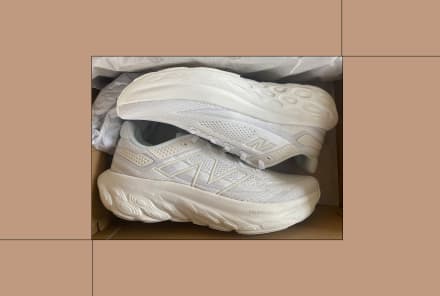Advertisement
Aerobic vs. Anaerobic Exercise: The Differences & How Often To Do Each

We know that regular exercise is key to good health. From blood pressure regulation to weight management and even disease prevention, movement offers research-backed benefit. And doing some exercise is always better than doing none. That said, is anaerobic or aerobic exercise more effective?
Both anaerobic and aerobic exercise can support several health goals. We tapped experts to weigh the unique benefits of each and offer insights on how to fit them into a balanced workout plan. Here's what you need to know about anaerobic versus aerobic exercise.
The need-to-knows:
- Aerobic and anaerobic exercise are both important: Both anaerobic and aerobic exercise can support several health goals. One isn't inherently better than the other, and they work best in tandem.
- Recovery is key: Doing too much high-intensity anaerobic activity and not enough relaxed aerobic activity can lead to injury, burnout, and hormonal imbalance.
- Everyone's different: Experts recommend doing anaerobic exercise two to three times a week and aerobic exercise three to four times a week. However, the ideal schedule will vary from person to person.
Aerobic exercise
Aerobic exercise, also known as endurance or cardio activity, is defined by the American College of Sports Medicine (ACSM) as any activity that uses your large muscles in a rhythmic manner and can be maintained continuously.
Engaging in aerobic activities increases your cardiovascular endurance, strengthens your heart, and improves your body's ability to use oxygen efficiently.
Research also shows1 that aerobic exercise can reverse and prevent cardiovascular disease, reduce the risk of chronic diseases, improve cholesterol, and aid in weight management when combined with a balanced diet.
So, how can you know if you're in an aerobic zone? One option is to keep tabs on your heart rate during exercise using a heart rate monitor. Aim for a heart rate between 60 and 80% of your maximum heart rate during aerobic activities. No heart rate monitor? You can also use rate of perceived exertion (RPE) to measure intensity level.
"In practice, an RPE scale of 1 to 10 is used, with 1 being very light and 10 being maximum effort. This gives you subjective information on how [you] feel during the exercise, and not just [your] physiological response to the demand," explains exercise physiologist Rachelle Reed, Ph.D. "A 3 to 5 or 6 would typically be aerobic work."
Examples of aerobic exercise:
- Cycling
- Brisk walking
- Dancing
- Hiking
- Jogging or running
- Swimming
How to prepare for aerobic exercise:
A few hours before aerobic exercise, fuel your body with a balanced meal containing carbohydrates, proteins, and fats. Warm up with light cardio and dynamic stretches to prepare your muscles and joints for physical activity.
How often to do aerobic exercise:
Schedule your aerobic workouts at least three to four times a week (for at least 30 minutes at a time) for optimal results.
Summary
Anaerobic exercise
Anaerobic exercise involves short bursts of intense activity, pushing your muscles to work without oxygen.
This type of training promotes muscle growth, increases strength, and enhances power and speed. Research indicates1 that anaerobic exercise can boost fat metabolism, improve insulin sensitivity, and support weight loss. Anaerobic exercise may also benefit the cardiovascular system.
To engage in anaerobic exercise, focus on high-intensity, short-duration activities that leave you breathless. If you can't sustain the activity for more than a minute or two, you're likely in the anaerobic zone.
Again, your heart rate tracker can help you estimate when you're in this zone. "In the absence of having a VO2 max test completed in an exercise science or sports performance lab and understanding your true max heart rate and lactate and ventilatory thresholds, everyday athletes can estimate their aerobic and anaerobic zones using heart rate data from a wearable tracker," says Reed. "For instance, WHOOP defines the anaerobic zone as 80% of your max heart rate or higher (zones four and five)."
If you don't have a monitor, Reed says you can also try the "talk test" while exercising to see if you've reached an anaerobic level. During this type of exercise, you won't be able to have a full conversation. You'll likely only be able to gasp out one to two words at a time, usually during your exhales. On the RPE scale, a 7 to 10 would be reflective of anaerobic work.
Examples of anaerobic exercise:
- Sprinting
- High-intensity interval training (HIIT)
- Lifting heavy weights
- Plyometric and ballistic-style exercises like jumping and throwing movements
- Jumping rope
How to prepare for anaerobic exercise:
Since anaerobic exercise requires a lot of energy, it's important to eat a balanced meal a few hours before training. Protein-rich foods are also beneficial as they'll help your muscles recover and grow. Warm up with light aerobic exercises and dynamic stretches.
How often to do anaerobic exercise:
Schedule anaerobic sessions two to three times a week (for at least 20 minutes at a time), allowing your muscles to recover between sessions.
Summary
Is one better?
There's a lot of debate about whether anaerobic or aerobic exercise is superior for certain benefits like fat burn, cardiovascular health, mood, longevity, and hormone health. Here's what the experts we spoke with say about which is more effective for different goals.
For fat burn: A combo of both
Both aerobic and anaerobic exercises are effective for burning fat. "Aerobic exercise burns fat during the activity, while anaerobic exercise can lead to higher calorie burn for hours after the workout (afterburn effect)," says Louisa Nicola, a neurophysiologist and advisory board member for Momentous. "The best approach for fat loss should include a combination of both."
For cardiovascular health: A combo of both
Although most people associate aerobic exercise with cardiovascular health1, cardiologist Michael Twyman, M.D., says there isn't a clear winner because both types of exercise offer distinct and complementary benefits.
Aerobic exercise enhances cardiovascular endurance and overall stamina. From a health perspective, aerobic exercise can help lower blood pressure and improve lipid profiles for cholesterol management. Anaerobic exercise improves heart strength by building a stronger heart and enhancing its pumping efficiency. Anaerobic exercise also increases VO2 max, the body's ability to use oxygen during intense exercise.
"Incorporating both types of exercise harnesses the unique benefits of each, offering a well-rounded approach to cardiovascular fitness," says Twyman. "Mixing aerobic and anaerobic exercises keeps workouts varied and interesting, reducing boredom and promoting adherence to exercise routines."
For improving mood: Aerobic
Both aerobic and anaerobic exercise have been shown to improve mood and reduce depression2. "Aerobic exercise has been traditionally associated with endorphin release3 and stress reduction," says Nicola. "While anaerobic exercise, particularly strength training, has been linked to improvements in mood and self-esteem."
However, when done outdoors4, aerobic exercise offers an added advantage by connecting you with nature and enhancing overall sense of well-being.
For supporting longevity: A combo of both
Studies suggest5 that engaging in regular aerobic activities like brisk walking or jogging can increase life span. However, a combination of aerobic and anaerobic exercises provides comprehensive health benefits and can contribute to longevity by reducing risk factors for chronic diseases.
"A combination of aerobic and anaerobic exercise appears to be most effective at promoting longevity compared to either type alone," says Matt Kaeberlein, Ph.D., a biologist, biogerontologist, and scientific advisory board member for Lifespan.io. "One recent study6 found that both moderate and vigorous aerobic exercise combined with two or more anaerobic muscle-strengthening exercise sessions per week was associated with the greatest reduction in mortality."
For hormone health: A (balanced) combo of both
Exercise has short- and long-term effects on hormones and cortisol levels3. Exercise physiologist Alyssa Olenick, Ph.D., explains that both aerobic and anaerobic exercise will increase cortisol (the stress hormone) as this is a general response to exercise. However, the response will be higher for high-intensity training and long-duration aerobic exercise.
"It's not that one's better or one's worse than the other. It's that people misuse or abuse the intensity of cardiovascular training," says Olenick. "People tend to have too much HIIT or too much moderate- to hard-intensity training all the time and not enough of the lower-intensity aerobic training that's more recoverable and not as stressful on your body to be doing."
The key, says Olenick, is to balance training intensities across the week, especially for those who do a lot of higher or even moderate volumes of cardiovascular activity and to consume adequate energy (food) to support training.
Kaeberlein adds that the cortisol-elevating effects of exercise should not persist unless you are overtraining. "Both aerobic and anaerobic exercise can reduce overall cortisol levels7 by reducing stress and can also help maintain general hormone health by reducing adiposity and delaying aging."
A sample schedule
The ACSM and CDC recommend that all healthy adults aged 18 to 65 participate in moderate-intensity aerobic physical activity for a minimum of 30 minutes five days per week or vigorous-intensity aerobic activity for a minimum of 20 minutes three days per week. The Physical Activity Guidelines (PAG) also recommend that adults participate in resistance training for a minimum of two days per week.
"Exercise prescription always depends upon the individual and what works for their short- and long-term health and performance goals," says Reed. "But generally, we want to think about meeting the PAG as your first benchmark—at least two days of resistance exercise weekly (technically anaerobic if you are lifting appropriate loads) and at least 150 minutes of moderate-intensity cardiovascular (or 75 minutes of vigorous-intensity cardiovascular) exercise per week."
Nicola says an ideal workout schedule might include two to three days of aerobic exercises, two to three days of anaerobic exercises, adequate rest days for recovery, and variation in workout types and intensities to maintain motivation and avoid overtraining. Here is a sample schedule to make your own:
- Monday: Aerobic exercise (30-60 minutes of brisk walking or running)
- Tuesday: Anaerobic exercise (total body resistance training)
- Wednesday: Aerobic exercise (30-40 minutes of brisk walking or running)
- Thursday: Anaerobic exercise (total body resistance training)
- Friday: Aerobic exercise (30-60 minutes of cycling or swimming)
- Saturday: Rest or yoga
- Sunday: Anaerobic exercise (15-20 minutes of HIIT)
If you're doing more training volume across the week than the PAG, Olenick says you want most of your training to be aerobic, lower intensity, and then some of your training each week (around 20 to 30%) to be that high-intensity, short-duration exercise so you can balance the intensities and recover properly.
If meeting the weekly Physical Activity Guidelines is not possible, some activity is still better than none, advises Reed. "In fact, the largest protective benefits of physical activity seem to occur when someone goes from almost no activity per week to some activity per week."
Concurrent training
Research has indicated that combined aerobic and anaerobic training (concurrent training) may improve aerobic performance8 more than aerobic training alone. High-intensity interval training (HIIT) is an example of concurrent training.
"Combining anaerobic and aerobic training in HIIT provides both cardiovascular and muscular benefits in less time," says Nicola. "It can be more engaging and diverse than steady-state workouts and may lead to significant improvements in endurance, strength, and weight loss."
On the flip side, Nicola adds that concurrent training comes with a higher risk of injury due to the intense nature and, therefore, might not be suitable for everyone, particularly those with certain health conditions. HIIT can also lead to overtraining or burnout without proper rest and recovery.
High-intensity interval training has become so colloquialized that many people don't truly understand what it actually is and isn't. The ACSM defines HIIT as alternating between periods of very high-intensity work (performed at 80% maximum heart rate or higher), followed by varying periods of recovery performed at 40-50% of maximum heart rate—or total rest.
"True HIIT is very difficult and uncomfortable and is meant to stress and train your anaerobic energy pathways. What we tend to see more often in the group fitness or digital fitness areas are better described as interval training," explains Reed. "Rather, they're staying in heart rate training zones 3, 4, and 5, alternating between higher intensity work and steady state moderate intensity work—never returning to the 40 to 50% actual recovery between 'all out' efforts."
That's not to say that the moderate-vigorous group exercise classes aren't beneficial, but there is something to be said about returning to lower- to moderate-intensity zone 2 work for building your aerobic base.
Summary
The mindbodygreen POV
Both anaerobic and aerobic exercise can support a number of health goals—from increasing strength to staving off cardiovascular disease. Most of the literature on exercise physiology suggests that doing a mix of both is the most effective way to train.
Experts recommend doing anaerobic exercise (i.e., weightlifting, running) two to three times a week for 20 minutes at a time and aerobic exercise (i.e., jogging, swimming) three to four times a week for 30 minutes at a time. This is a good place to start, though the ideal workout regimen will vary from person to person. And any physical activity is better than none!
Doing both types of training may also reduce your risk of injury. Doing too much anaerobic activity without balancing it out with more sustainable aerobic activity can lead to injury, burnout, and hormonal imbalance. While you can do anaerobic and aerobic training in the same HIIT-style workout, doing this too often can lead to burnout and injury.
Try to take your aerobic activity outdoors to further maximize its mental health benefits.
Special considerations
The Physical Activity Guidelines (PAG) for Americans is very clear in stating that the benefits of physical activity far outweigh the risks for all people. However, Reed advises that there are some best practices to be mindful of.
"Gradual progression is key with any exercise program. Doing too much too soon can not only increase the risk for injury or cardiac event, but it can also become less enjoyable, making it harder to sustain positive exercise behaviors long term," she says.
If you have been told not to engage in vigorous-intensity training, consult a doctor or exercise physiologist before starting a structured training program. "If you have uncontrolled heart disease, hypertension, or other cardiometabolic diseases, working with a certified exercise physiologist can help mitigate the risk and ensure you're responding appropriately to the new-to-you-stress of exercise," adds Reed.
Pregnant women are encouraged to continue (or start) exercise programs by the American College of Obstetricians and Gynecologists (ACOG), but they should do so with knowledge of appropriate modifications and care from a certified trainer who has additional training with that population.
FAQ
Which is better, aerobic or anaerobic exercise?
Both anaerobic and aerobic exercise are very healthy. One isn't better than the other, and most people will want to do a combination of the two every week. They offer complementary benefits for heart health, body composition and fat loss, mood, and more.
Does anaerobic burn fat vs. aerobic?
Both aerobic and anaerobic exercises are effective for burning fat. Aerobic exercises are excellent for burning calories during the workout, while anaerobic exercises continue to burn calories even after the workout is done.
Is jogging aerobic or anaerobic?
Jogging is an aerobic exercise. It uses your large muscles in a rhythmic manner and can be maintained continuously for a long period of time.
The takeaway
We think the best exercise is the one you'll stick with, but it's valuable to mix up your workouts and combine aerobic and anaerobic training in your weekly schedule whenever possible. Ready to work some new types of training into your routine? Check out these comprehensive beginner's guides to running and resistance training.
8 Sources
- https://www.ncbi.nlm.nih.gov/pmc/articles/PMC5329739/
- https://pubmed.ncbi.nlm.nih.gov/30321106/
- https://www.ncbi.nlm.nih.gov/pmc/articles/PMC5928534/
- https://pubmed.ncbi.nlm.nih.gov/21288543/
- https://www.ncbi.nlm.nih.gov/pmc/articles/PMC3191604/
- https://jamanetwork.com/journals/jamainternalmedicine/article-abstract/2807854
- https://pubmed.ncbi.nlm.nih.gov/35777076/
- https://www.ncbi.nlm.nih.gov/pmc/articles/PMC5154721/
Watch Next
Enjoy some of our favorite clips from classes
Enjoy some of our favorite clips from classes
What Is Meditation?
Mindfulness/Spirituality | Light Watkins
Box Breathing
Mindfulness/Spirituality | Gwen Dittmar
What Breathwork Can Address
Mindfulness/Spirituality | Gwen Dittmar
The 8 Limbs of Yoga - What is Asana?
Yoga | Caley Alyssa
Two Standing Postures to Open Up Tight Hips
Yoga | Caley Alyssa
How Plants Can Optimize Athletic Performance
Nutrition | Rich Roll
What to Eat Before a Workout
Nutrition | Rich Roll
How Ayurveda Helps Us Navigate Modern Life
Nutrition | Sahara Rose
Messages About Love & Relationships
Love & Relationships | Esther Perel
Love Languages
Love & Relationships | Esther Perel

















